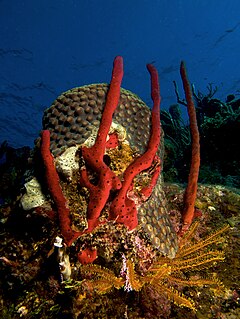
Agelas clathrodes, also known as the orange elephant ear sponge, is a species of sea sponge. It lives on reefs in the Caribbean, usually more than 10 metres (33 ft) below the surface of the ocean. It takes various forms, and its color is reddish orange.
Arturia canariensis, commonly known as the yellow calcareous sponge, is a species of sponge in the family Clathrinidae. It is found in shallow seas in the Canary Islands, Cape Verde, the Adriatic Sea and the Caribbean Sea. The specific epiphet "canariensis" was given to this species because it was first described from Lanzarote in the Canary Islands.

Oreaster reticulatus, commonly known as the red cushion sea star or the West Indian sea star, is a species of marine invertebrate, a starfish in the family Oreasteridae. It is found in shallow water in the western Atlantic Ocean and the Caribbean Sea.

Amphimedon compressa, the erect rope sponge, red tree sponge, red tubular sponge, or red sponge is a demosponge found in southern Florida, the Caribbean Sea, and the Bahamas. It can be deep red, orange, brown, or black.

Umimayanthus parasiticus, commonly known as the sponge zoanthid, is a species of coral in the order Zoantharia which grows symbiotically on several species of sponge. It is found in shallow waters in the Caribbean Sea and the Gulf of Mexico.

Agelas is a genus of sea sponge in the class Demospongiae.
Agelas schmidti, commonly known as the brown tubular sponge, is a species of demosponge. It occurs at moderate depths in the Gulf of Mexico and the Caribbean Sea and often has a colonial coral growing over the surface. The type locality is Puerto Rico.

Parazoanthus swiftii, commonly known as the golden zoanthid, is a species of coral in the order Zoantharia which grows symbiotically on several species of sponge. It is found in shallow waters in the Caribbean Sea and western Atlantic Ocean.
Iotrochota birotulata, commonly known as the green finger sponge, is a species of sea sponge in the family Iotrochotidae. It is found in shallow waters in the Caribbean Sea.
Neofibularia nolitangere, commonly known as the touch-me-not sponge, is a species of sea sponge in the family Biemnidae. It is found in shallow waters in the Western Atlantic Ocean and the Caribbean Sea.
Ophiothrix suensoni, Suenson's brittle star or the sponge brittle star, is a species of marine invertebrate in the order Ophiurida. It is found in the Caribbean Sea and Gulf of Mexico. It is included in the subgenus Acanthophiothrix making its full scientific name Ophiothrix (Acanthophiothrix) suensoni.

Plexaurella nutans, the giant slit-pore sea rod, is a tall species of soft coral in the family Plexauridae. It is a relatively uncommon species and is found in shallow seas in the Caribbean region.

Neopetrosia proxima is a species of marine petrosiid sponge native to the tropical and subtropical waters of the western Atlantic Ocean.
Neopetrosia subtriangularis is a species of marine petrosiid sponges native to the waters off Florida and the Caribbean Sea. They superficially resemble staghorn corals.

Aplysina is a genus of sea sponges in the order Verongiida. It was first authenticated and described by Nardo in 1834.

Agelas tubulata is a species of demosponge. It is tube-shaped or vase-shaped and variable in colour. It is found in the Caribbean area and along the coasts of Brazil at depths of between about 70 and 90 m. It was first described by Lehnert & van Soest in 1996, the type location being the Greater Antilles.
Agelas dispar is a species of demosponge in the family Agelasidae. It lives on shallow-water reefs in the Caribbean Sea and around the West Indies.

Aplysina fistularis, commonly known as the yellow sponge or yellow tube sponge, is a species of sea sponge in the order Verongiida. Aplysina fistularis is a golden or orange-brown color with a conulose surface. The animal is abundant in the Caribbean, where it is commonly found in reefs of open water areas. This sponge was first described by the Prussian zoologist Peter Simon Pallas in 1766.

Aplysina aerophoba is a species of sponge in the family Aplysinidae. It is a yellow, tube-forming or encrusting sponge and is native to the eastern Atlantic Ocean and the Mediterranean Sea; the type locality is the Adriatic Sea.









